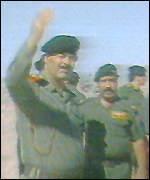Posted on July 10, 2006
Kay-O'd On WMD
The chief inspector takes a dive
by
Daniel Clark
While Iraq struggles to transform itself, there is no question that it has succeeded in transforming David Kay, the former UN and Pentagon weapons inspector who went to that country talking like Elliot Ness, and came back sounding like Alan Dershowitz. Three years ago, Kay told NBC's Tom Brokaw, "We will take as long as it takes," to present evidence of Saddam's weapons of mass destruction to the American people. Today, he's finding excuses to dismiss as irrelevant the discovery of hundreds of sarin and mustard gas munitions.

If anybody should be aiding the efforts of Rep. Peter Hoekstra (R, Mich.) and Sen. Rick Santorum (R, Pa.) to release Iraq's WMD documents, David Kay should. For it was he who told Brokaw that he'd discovered records showing Saddam's foreign procurement of WMD-related materials, as well as progress reports on the development of his WMD programs. He also explained that Saddam had a detailed plan for moving and hiding weapons, and for destroying and concealing their documentary evidence.
When Kay resigned as head of the Iraq Survey Group in January 2004, he said, "[w]e were all wrong" about Saddam's WMD. In light of the certainty of his previous statements, that may sound like a humiliating admission. To the contrary, it becomes self-congratulatory when taken in the context of his explanation that, "I think there were stockpiles at the end of the first Gulf War, and a combination of UN inspectors and unilateral Iraqi action got rid of them."
The Iraq Survey Group Report (a.k.a., the Duelfer Report) went even further, crediting the inspector by name. "An IAEA inspection led by Dr. David Kay in late June 1991 triggered Iraq's decision to unilaterally destroy the undeclared weapons that had been concealed from the UN, according to multiple senior Iraqi officials," it said.
The report does concede that "a small number of old, abandoned chemical munitions have been discovered." Now we find, thanks to Hoekstra and Santorum, that this "small number" is at least 500. Knowing, as Kay does, that Saddam's officials were "assiduous as record-keepers," it's difficult to picture the Iraqi dictator surrounded by aides, all scratching their heads and wondering just where they'd misplaced those 500 chemical weapons.
For so many WMD to be "abandoned," their overall number must have been far greater than most people had supposed. Yet according to the unilateral destruction theory, those massive stockpiles were successfully concealed from the inspectors, and then were rounded up and destroyed, also while avoiding detection.
That's just one of many aspects of this theory that ought to make any inspector skeptical. Another is the Duelfer Report's almost complete reliance on Saddam, his scientists and his officials for information. All they needed to do is to stick to their rehearsed cover stories, and the report accepted those stories as factual. It didn't hurt that the tales tended to flatter the inspectors who produced the report.

Then, there are the incongruities that arise from the report's timeline, which shows that Saddam had continued his efforts to produce ricin and other biological agents for years after all the WMD were supposedly destroyed. He'd only owned up to the program in 1995, after inspectors discovered 42 tons of growth medium. In 1998, inspectors found traces of VX nerve agent on warhead fragments, a discovery that led President Clinton to launch Operation Desert Fox. Afterward, Saddam barred the inspectors for almost four years.
In order for the theory to work, one must believe: (a) that the inspectors scared Saddam out of arming himself with mustard and sarin gas, but did not deter him from trying to weaponize other deadly agents; and (b) that he did not take advantage of their absence after evicting them. But that's not all. One must also believe that the purchase records and progress reports that Kay had seen were falsified, that Saddam's meetings with his scientists were staged for our benefit, and that all the concealment efforts were just an elaborate pantomime. That includes Kay's own testimony about convoys fleeing toward Syria just before the invasion.
So how can David Kay profess to believe such a preposterous theory? Easy. As long as he buys into the story, he portrays himself as the hero, the cavalryman whose gallant charge scared the villain into throwing down his guns. If on the other hand, he admits that at least 500 chemical weapons have been found, and that many times more could have been successfully hidden or moved, he casts himself as little more than comic relief.
-- Daniel Clark is a Staff Writer for the New Media Alliance. The New Media Alliance is a non-profit (501c3) national coalition of writers, journalists and grass-roots media outlets.
The Shinbone: The Frontier of the Free Press
Mailbag . Issue Index . Politimals